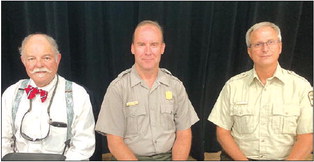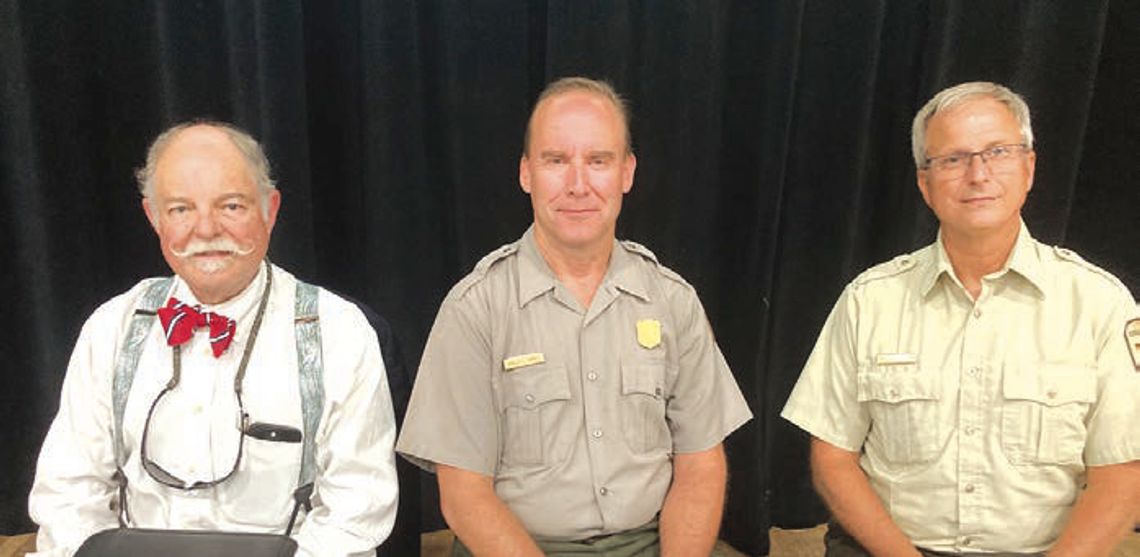Three-person panel provides information in 2-hour meeting
A three-person panel provided information and fielded questions from concerned citizens during Tuesday night’s two-hour community meeting at the C.C. McCray City Auditorium regarding the Okefenokee National Wildlife Refuge’s UNESCO World Heritage Site bid.
The August 13 event was moderated by Patrick Simmons, Director of the Waycross Convention and Visitors Bureau and City of Waycross Business Integration and Information Systems Director, the panelists were Dr. William Clark, chairman of the Okefenokee Swamp Park Board of Trustees, Barclay Trimble, superintendent of Mammoth Cave National Park and World Heritage Site and former deputy superintendent of Grand Canyon National Park, and Michael Lusk, Refuge Manager of the Okefenokee National Wildlife Refuge.
Approximately 200 community members with a wide variety of opinions, questions and concerns attended. With the exception of one man who used his two minutes for a political rant, the audience was overall courteous and well behaved.
Each of the three panelists was given 15 minutes presentation time. The first to present was Dr. Clark who gave an overview of the Swamp Park, its relationship to the refuge, and a summation of the World Her-itage Site (WHS) bid.
The Swamp Park has been on a tentative list for becoming a WHS since 1982. The park is a private non-profit organization located on 1,200 acres at the southern end of the Dixon Memorial State Forest. The land is leased from the state of Georgia and is in its second 50 year lease with the state.
The Okefenokee National Wildlife Refuge, 407,000 acres of federally protected and managed land, protects about 93% of the swamp. The refuge does not contain state or private land.
In 2023, the park received permission from the U.S. Department of Interior to actively pursue a bid. The cost of preparing the extensive application is $500,000. This fee is being raised through private donations.
“The public/private partnership to pay the Department of Interior $500,000 will pay for botanists, scientists, people from universities, experts to prepare the paperwork,” explained Dr. Clark. “No money is paid to the United Nations or to UNESCO.”
One of the driving forces behind seeking WHS designation is the promise of a possible positive economic impact for Waycross, Folkston, Homerville and other surrounding communities.

Approximately two hundred concerned citizens were in attendance at the C.C. McCray City Auditorium for the community information meeting regarding the Okefenokee National Wildlife Refuge’s UNESCO World Heritage Site bid. Photo By EJ POND

The three-person panel included (l-r) Dr. William Clark, chair of the Okefenokee Swamp Park Board of Trustees, Barclay Trimble, superintendent of Mammoth Cave National Park in Kentucky, and Michael Lusk, refuge manager of the Okefenokee National Wildlife Refuge. Photo By EJ POND
“An economic impact study published earlier this year by The Conservation Fund estimates the number of swamp related jobs will double to 1,500 and revenues will increase to $140 million a year,” said Clark.
The United States is currently home to 25 World Heritage Sites. Yellowstone National Park, mostly in Wyoming, and Mesa Verde National Park, in southwest Colorado, became the first two WHS in the United States in 1978.
Several attendees expressed concerns regarding the possible loss of sovereignty of the refuge.
“It is a designation only,” responded Dr. Clark. “It does not involve sovereignty in any way. The Okefenokee will always remain the property of the United States of America. It does not limit private property rights, it will not limit private hunting or fishing rights around the swamp, it will not affect the proposed titanium mine in Folkston.”
Lusk further explained the process of a WHS designation.
“It’s (WHS designation) an executive action,” said Lusk. “It doesn’t go through congress. Congress does not vote on whether or not an area becomes a World Hermitage Site.
“The President of the United States delegates it to the Secretary of Interior who approves sites to be nominated. Last year we received approval from the Department of the Interior to seek a nomination as a World Heritage Site.”
Lusk reiterated the verbiage in the convention document signed by President Richard Nixon.
“It says directly and explicitly, at any World Heritage Site the sovereign control of that site is retained by the nation in which it resides,” Lusk said. “It says very clearly in black and white there is no loss of sovereignty.
“I like to say it’s like getting a five star Yelp review by the United Nations saying this is a significant spot in the entire world. It’s possible to have concerns about the UN or UNESCO but still see value in the World Heritage Site program.”
Several audience members also expressed concerns about United Nations interference in the management of the refuge.
Lusk asked Trimble how the UN interacts with World Heritage Sites in the United States and how and if he has ever been asked to implement agenda 2030 or anything similar.
“The answer is no,” said Trimble. “We have not lost any sovereignty. In my 12 years with international sites, I have had zero communication with the United Nations.”
Since the program’s inception, there has been bipartisan support for World Heritage Sites despite concerns about the United Nations.
Trimble added an important caveat to the conversation.
“There is always an opportunity if a particular site is not happy with the designation, they can withdraw,” assured Trimble. “It’s just a designation, a piece of paper which says ‘This is a world renowned natural resource that you may want to come and see and experience.’” There will be a meeting Thursday, August 22 at the Waycross Exchange Club at 7 p.m., with a presentation by Alex Newman followed by a question and answer period. Newman is CEO of Liberty Sentinel Media. More information can be found at www.libertysentenel. org.
The economic study done by The Conservation Fund can be found on the Swamp Park website www.okeswamp.org.
More information about Agenda 2030 can be found at www.un.org.
http://www.okeswamp.org










